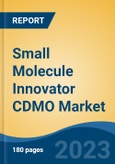Speak directly to the analyst to clarify any post sales queries you may have.
10% Free customizationThis report comes with 10% free customization, enabling you to add data that meets your specific business needs.
Small Molecule Innovator CDMOs are specialized entities that support pharmaceutical and biotech companies through comprehensive services that span from early-stage development to commercial production of small molecule APIs and finished drug products.
Market Growth Drivers
Increasing Trend Toward Outsourcing
The growing trend of outsourcing in the Small Molecule Innovator CDMO market is a strategic response by pharmaceutical and biotechnology companies seeking to optimize drug development and resource allocation. Outsourcing enables firms to improve operational efficiency, leverage specialized expertise, and accelerate time-to-market.Partnering with CDMOs offers significant advantages. These organizations bring in-depth knowledge of formulation development, process optimization, analytical testing, and regulatory compliance - capabilities critical to the successful development of small molecule therapeutics. By outsourcing these functions, pharmaceutical innovators can avoid the substantial investments associated with building in-house capabilities, while still benefiting from cutting-edge technologies and proven processes.
Moreover, the complex and multidisciplinary nature of modern drug development requires agility and regulatory acumen - qualities that CDMOs are well-equipped to provide. These partnerships also allow innovator companies to maintain focus on their core strengths, such as research and clinical development, while entrusting manufacturing and operational tasks to experienced partners.
Market Challenges
Intellectual Property (IP) Protection
A key challenge in the Small Molecule Innovator CDMO market is the safeguarding of intellectual property. Innovator companies often invest heavily in R&D to create novel compounds and proprietary manufacturing processes. When entering into CDMO partnerships, they must share confidential data, including chemical structures, synthetic methodologies, and analytical techniques.This exchange introduces risks related to IP leakage or unauthorized disclosure. To mitigate these concerns, companies typically implement strict confidentiality agreements (e.g., Non-Disclosure Agreements or NDAs) outlining terms for the sharing, usage, and protection of proprietary information. These legal safeguards are critical to maintaining trust and securing competitive advantages throughout the development lifecycle.
Market Trends
Emergence of Personalized Medicine and Niche Therapies
Personalized medicine and niche therapies are reshaping the pharmaceutical landscape by focusing on customized treatment strategies based on individual patient profiles or targeting specific populations with unique health conditions.In this context, the Small Molecule Innovator CDMO market is playing an increasingly vital role. Personalized medicine seeks to enhance therapeutic outcomes by aligning treatment strategies with a patient’s genetic characteristics, lifestyle, and disease-specific biomarkers. Innovator companies are developing small molecule drugs that target these unique markers, offering improved efficacy and reduced side effects.
CDMOs are instrumental in bringing these therapies to market. Their expertise in molecular biology, pharmacogenomics, and analytical chemistry enables them to support the development and manufacturing of tailored treatments. These capabilities are essential to ensuring the precision, scalability, and regulatory compliance required for personalized therapies.
Key Market Players
- Lonza Group AG
- Thermo Fisher Scientific Inc
- Cambrex Corporation
- Catalent, Inc
- Siegfried Holding AG
- Recipharm AB
- Corden Pharma GmbH
- Boehringer Ingelheim GmbH
- Piramal Pharma Solutions
- LABCORP HOLDINGS INC.
Report Scope:
In this report, the Global Small Molecule Innovator CDMO Market has been segmented into the following categories, in addition to the industry trends which have also been detailed below:Small Molecule Innovator CDMO Market, By Product:
- Small Molecule API
- Small Molecule Drug Product
Small Molecule Innovator CDMO Market, By Stage Type:
- Preclinical
- Clinical
- Commercial
Small Molecule Innovator CDMO Market, By Customer Type:
- Pharmaceutical
- Biotechnology
Small Molecule Innovator CDMO Market, By Therapeutic Area:
- Cardiovascular disease
- Oncology
- Respiratory disorders
- Neurology
- Metabolic disorders
- Infectious disease
- Others
Small Molecule Innovator CDMO Market, By Region:
- North America
- United States
- Canada
- Mexico
- Europe
- Germany
- France
- United Kingdom
- Italy
- Spain
- Asia-Pacific
- China
- Japan
- India
- South Korea
- Australia
- South America
- Brazil
- Argentina
- Colombia
- Middle East & Africa
- UAE
- Saudi Arabia
- South Africa
Competitive Landscape
Company Profiles: Detailed analysis of the major companies present in the Global Small Molecule Innovator CDMO Market.Available Customizations:
With the given market data, the publisher offers customizations according to a company's specific needs. The following customization options are available for the report.Company Information
Detailed analysis and profiling of additional market players (up to five).This product will be delivered within 1-3 business days.
Table of Contents
Companies Mentioned
- Lonza Group AG
- Thermo Fisher Scientific Inc
- Cambrex Corporation
- Catalent, Inc
- Siegfried Holding AG
- Recipharm AB
- Corden Pharma GmbH
- Boehringer Ingelheim GmbH
- Piramal Pharma Solutions
- Labcorp Early Development Laboratories Ltd
Table Information
| Report Attribute | Details |
|---|---|
| No. of Pages | 185 |
| Published | April 2025 |
| Forecast Period | 2024 - 2030 |
| Estimated Market Value ( USD | $ 48.26 Billion |
| Forecasted Market Value ( USD | $ 72.26 Billion |
| Compound Annual Growth Rate | 6.9% |
| Regions Covered | Global |
| No. of Companies Mentioned | 10 |









